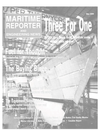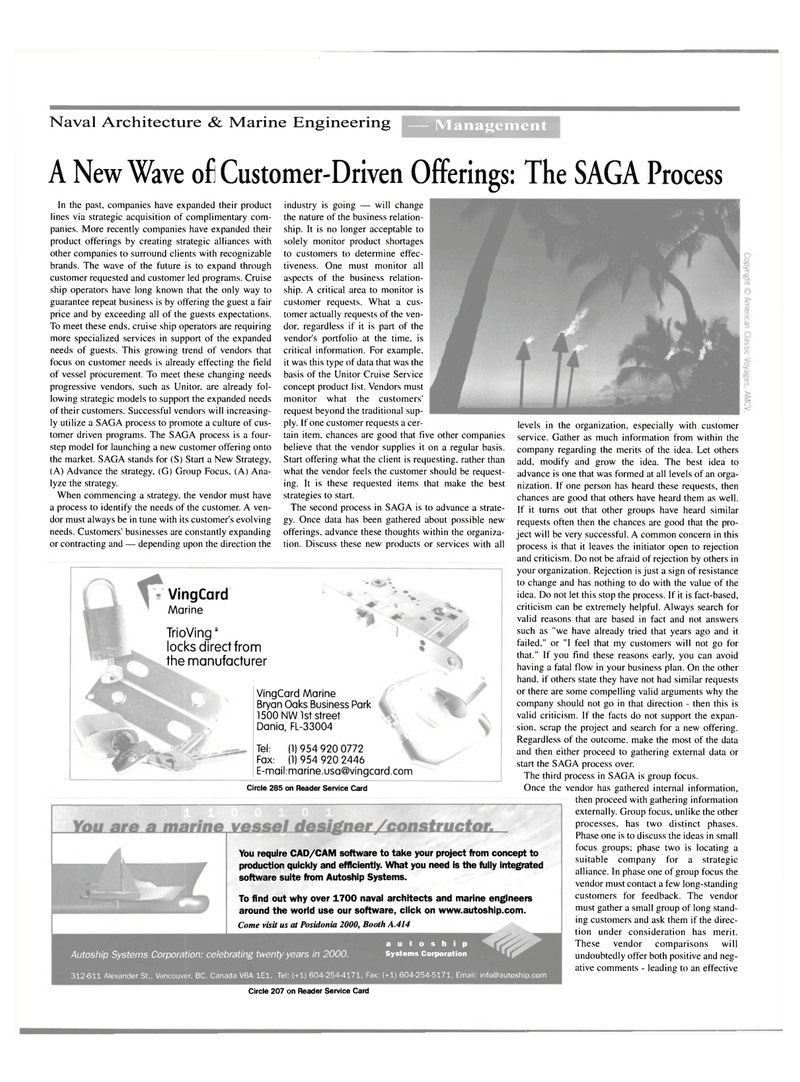
Page 40: of Maritime Reporter Magazine (May 2000)
Read this page in Pdf, Flash or Html5 edition of May 2000 Maritime Reporter Magazine
Naval Architecture & Marine Engineering Management
A New Wave of Customer-Driven Offerings: The SAGA Process
In the past, companies have expanded their product lines via strategic acquisition of complimentary com- panies. More recently companies have expanded their product offerings by creating strategic alliances with other companies to surround clients with recognizable brands. The wave of the future is to expand through customer requested and customer led programs. Cruise ship operators have long known that the only way to guarantee repeat business is by offering the guest a fair price and by exceeding all of the guests expectations.
To meet these ends, cruise ship operators are requiring more specialized services in support of the expanded needs of guests. This growing trend of vendors that focus on customer needs is already effecting the field of vessel procurement. To meet these changing needs progressive vendors, such as Unitor, are already fol- lowing strategic models to support the expanded needs of their customers. Successful vendors will increasing- ly utilize a SAGA process to promote a culture of cus- tomer driven programs. The SAGA process is a four- step model for launching a new customer offering onto the market. SAGA stands for (S) Start a New Strategy, (A) Advance the strategy, (G) Group Focus, (A) Ana- lyze the strategy.
When commencing a strategy, the vendor must have a process to identify the needs of the customer. A ven- dor must always be in tune with its customer's evolving needs. Customers' businesses are constantly expanding or contracting and — depending upon the direction the industry is going — will change the nature of the business relation- ship. It is no longer acceptable to solely monitor product shortages to customers to determine effec- tiveness. One must monitor all aspects of the business relation- ship. A critical area to monitor is customer requests. What a cus- tomer actually requests of the ven- dor, regardless if it is part of the vendor's portfolio at the time, is critical information. For example, it was this type of data that was the basis of the Unitor Cruise Service concept product list. Vendors must monitor what the customers' request beyond the traditional sup- ply. If one customer requests a cer- tain item, chances are good that five other companies believe that the vendor supplies it on a regular basis.
Start offering what the client is requesting, rather than what the vendor feels the customer should be request- ing. It is these requested items that make the best strategies to start.
The second process in SAGA is to advance a strate- gy. Once data has been gathered about possible new offerings, advance these thoughts within the organiza- tion. Discuss these new products or services with all
VingCard
Marine
TrioVing5 locks direct from manufacturer the
VingCard Marine
Bryan Oaks Business Park 1500 NW 1st street
Dania, FL-33004
Tel: (1) 954 920 0772
Fax: (1) 954 920 2446
E-mail:marine. [email protected]
Circle 285 on Reader Service Card
You require CAD/CAM software to take your project from concept to production quickly and efficiently. What you need is the fully integrated software suite from Autoship Systems.
To find out why over 1700 naval architects and marine engineers around the world use our software, click on www.autoship.com.
Come visit us at Posidonia 2000, Booth A.414
Autoship Systems Corporation: celebrating twenty years in 2000. autoship
Systems Corporation 312-611 Alexander St., Vancouver. BC, Canada V6A 1E1. Tel: (+1) 604-254-4171, Fax: (+1) 604-254-5171, Email: [email protected] levels in the organization, especially with customer service. Gather as much information from within the company regarding the merits of the idea. Let others add, modify and grow the idea. The best idea to advance is one that was formed at all levels of an orga- nization. If one person has heard these requests, then chances are good that others have heard them as well.
If it turns out that other groups have heard similar requests often then the chances are good that the pro- ject will be very successful. A common concern in this process is that it leaves the initiator open to rejection and criticism. Do not be afraid of rejection by others in your organization. Rejection is just a sign of resistance to change and has nothing to do with the value of the idea. Do not let this stop the process. If it is fact-based, criticism can be extremely helpful. Always search for valid reasons that are based in fact and not answers such as "we have already tried that years ago and it failed." or "I feel that my customers will not go for that." If you find these reasons early, you can avoid having a fatal flow in your business plan. On the other hand, if others state they have not had similar requests or there are some compelling valid arguments why the company should not go in that direction - then this is valid criticism. If the facts do not support the expan- sion. scrap the project and search for a new offering.
Regardless of the outcome, make the most of the data and then either proceed to gathering external data or start the SAGA process over.
The third process in SAGA is group focus.
Once the vendor has gathered internal information, then proceed with gathering information externally. Group focus, unlike the other processes, has two distinct phases.
Phase one is to discuss the ideas in small focus groups; phase two is locating a suitable company for a strategic alliance. In phase one of group focus the vendor must contact a few long-standing customers for feedback. The vendor must gather a small group of long stand- ing customers and ask them if the direc- tion under consideration has merit.
These vendor comparisons will undoubtedly offer both positive and neg- ative comments - leading to an effective
Circle 207 on Reader Service Card

 39
39

 41
41
